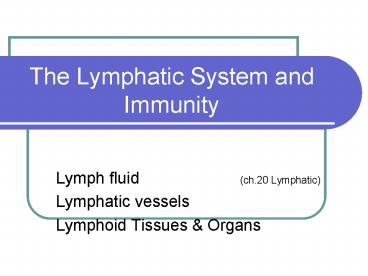The Lymphatic System and Immunity - PowerPoint PPT Presentation
1 / 30
Title:
The Lymphatic System and Immunity
Description:
The Lymphatic System and Immunity Lymph fluid (ch.20 Lymphatic) Lymphatic vessels Lymphoid Tissues & Organs Lymphatic and Immune System Immune response specific ... – PowerPoint PPT presentation
Number of Views:403
Avg rating:3.0/5.0
Title: The Lymphatic System and Immunity
1
The Lymphatic System and Immunity
- Lymph fluid (ch.20 Lymphatic)
- Lymphatic vessels
- Lymphoid Tissues Organs
2
Lymphatic and Immune System
- Immune response specific defense
- Immunity ability to resist infection disease
through activation of specific defenses
3
Major Functions
- Produce, maintain, distribute lymphocytes
- Return fluids and solutes from peripheral tissues
of blood - Distribute hormones, nutrients, waste products
from tissues of origin to the general circulation
4
Lymphatic Vessels
- Lymph flows along lymphatics with help of valves
which respond to pressure from interstitial
capillary volumes - Originate in lymphatic capillaries, end in
thoracic duct (body) and right lymphatic duct
(right side arm, head thorax) to circulatory
venous system - Fig. 20.1
5
Lymphocytes
- Three classes immunocompetent cells protect
against antigens - -T cells (thymus dependent)
- Cytotoxic- attack viral infected cells
- Helper-stimulate TB cells (regulatory)
- Suppressor-inhibit TB cells (regulatory)
- -B cells (bone marrow-derived)
- Plasma cells- mature B cells that secrete
antibodies (immunoglobulins) in response to a
specific antigen (protein generally, lipid,
saccharide, nucleic acid) - -NK cells (natural-killer)
- attack cancer cells, viral infected cells,
foreign cells
6
Lymphoid Tissues
- Lymphoid nodules include tonsils
(pharyngeal/adenoids, palatine, lingual), densely
packed in loose connective tissue - Peyers Patches (in sm.intestines) Appendix
- MALT bronchi, genitourinary
7
Lymphoid Organs fig.20.5
- Lymph nodes masses of lymph tissue filter and
purify lymph, efferent afferent Fig. 20.4
(cortex medulla) - Thymus epithelial cells produce thymus
hormones T cell production (cortex medulla) - Spleen largest mass of lymphoid tissue removes
abnormal blood through phagocytosis, store iron,
initiate immune response by B T cells
8
Body Defenses (ch.21 Immunity)
- 2 general categories
- -Nonspecific defenses (Innate) do not
discriminate, respond the same to all threats - -Specific defenses (Adaptive) (occur after
birth) discriminatory so only attack specific
threats
9
Nonspecific Defenses p. 796
- Physical Barriers
- Phagocytes
- Immunological Surveillance
- Interferons
- Complement
- Inflammation
- Fever
10
Physical Barriers fig. 21.4
- Keeps hazardous material outside body
- Skin, keratin, mucus
11
Phagocytes
- Cells that engulf pathogens and cell debris
- Ex Macrophages of peripheral tissues,
microphages of blood
12
Immunological Surveillance
- Destruction of abnormal cells by NK cells in
peripheral tissues - NK cells attack quickly, killing tumor-specific
antigens as well (cancer cells)
13
Interferons
- Chemical messengers coordinate defenses against
viral infection
14
Complement
- System of circulating proteins that assist
antibodies in destruction of pathogens - Activate via classic or alternate pathway
- Stimulate inflammation and enhance phagocytosis
15
Inflammation
- Local response to injury or infection at tissue
level - Restrict injury spread and combat infection
- Response to Injury steps 1-8
16
Fever
- Elevation in body temperature (via protein
pyrogen) to accelerate tissue metabolism and
defenses - Ex. Interleukins-1
17
Specific Response
- Immune Response Table 21.4
- -Forms of Immunity
- -Properties of Immunity
- -T cells
- -B cells
- -Responses to Antigen Exposure
18
Review of Forms of Immunity
- Innate genetically determined
- Active follows exposure to antigen
- -Naturally acquired after birth
- -Induced active immunization
- Passive transfer of antibodies
- -Natural mother to child
- -Induced administer antibodies
19
Properties of Immunity
- Specificity target specific pathogen
- Versatility differentiate among pathogens
- Memory stronger response after 2nd appearance
- Tolerance immune system does not respond to
normal pathogen
20
Antibodies
- Two parallel pairs of polypeptide chains bind to
antigen - Classes Table 21.3
- IgGlargest
- IgEattach to exposed surfaces
- IgDsurfaces of B cells
- IgMfirst type secreted after antigen arrival
- IgAglandular secretions
21
Antibodies Destroy Antigens
- Neutralizationblock binding site
- Agglutination precipitationform large immune
complexes - Activate complement
- Attract phagocytes
- Opsonizationcoat proteins for more effectiveness
- Stimulate inflammation
- Prevent bacterial, viral adhesion
22
Responses to Antigen Exposure
- Primary1st time antigen appears, gradual attack
- Secondary2nd time antigen appears, rapid
response via memory cells
23
Hormones of Immune System
- Interleukinsenhance defenses, stimulate T and B
cell activity - Interferons
- TNFsslow tumor growth
- CSFsstimulate blood cell production
24
Developing Resistance
- Immunological competenceability to demonstrate
immune response upon exposure
25
Immune Disorders
- Autoimmune disordermistakenly targets normal
cells - Immunodeficiencyimmune system blocked, fails
- Allergiesexcessive response to antigen
(hypersensitivity)
26
AIDS
- Caused by HIV
- Retrovirus (carries genetic information in RNA,
not DNA)
27
Stress and the Immune Response
- Depression of inflammatory response
- Reduction in phagocyte activity
- Inhibition of interleukin secretion
28
Aging and the Immune Response
- Less effective at combating disease
- Fewer T helper cells
- Vaccinations important for vulnerable elderly
29
Integration with Other Systems
- Provide IgA for secretion onto skin
- Cytokines affect CRH and TRH production
- Fight infections of respiratory, circulatory, and
digestive organs - Immune system is supplied by other systems equally
30
Questions or Comments?
- Works Cited
- Fundamentals of Anatomy and Physiology
(Martini) - http//www.mhhe.com/biosci/ap/holehaap/student/ol
c2/chapterindex16.htm - http//www.emc.maricopa.edu/faculty/farabee/BIOBK
/BioBookIMMUN.html - Du, et al.































